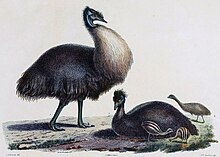fr
noms dans le fil d’Ariane


Dromaius (from greek δρομαίυς "runner") is a genus of ratite present in Australia. There is one extant species, Dromaius novaehollandiae commonly known as the emu.
In his original 1816 description of the emu, Louis Jean Pierre Vieillot used two generic names; first Dromiceius, then Dromaius a few pages later. Which label is correct has been a point of contention ever since; the latter is more correctly formed, but the convention in taxonomy is that the first name given stands, unless it is clearly a typographical error, as argued by W.B. Alexander.[2] For names published on the same day, or in the same publication, the International Code of Zoological Nomenclature states that both names have equal precedence, and that the Principle of First Reviser (Article 24.2 [3]) determines which name is to be used. Most modern publications, including those of the Australian government,[4] use Dromaius, with Dromiceius mentioned as an alternative spelling. Misspellings of both forms by later authors have produced further synonyms.[4] The Dromiceius spelling was the basis for Dale Russell's 1972 naming of the dinosaur Dromiceiomimus.

Several emu species were common prior to European settlement in 1788:
A number of other emu fossils from Australia described as separate species are now regarded as chronosubspecies at best, given the considerable variation even between living individuals.[9] There are also some unidentifiable remains of emu-like birds from rocks as old as the middle Miocene.[10]
Dromaius (from greek δρομαίυς "runner") is a genus of ratite present in Australia. There is one extant species, Dromaius novaehollandiae commonly known as the emu.
In his original 1816 description of the emu, Louis Jean Pierre Vieillot used two generic names; first Dromiceius, then Dromaius a few pages later. Which label is correct has been a point of contention ever since; the latter is more correctly formed, but the convention in taxonomy is that the first name given stands, unless it is clearly a typographical error, as argued by W.B. Alexander. For names published on the same day, or in the same publication, the International Code of Zoological Nomenclature states that both names have equal precedence, and that the Principle of First Reviser (Article 24.2 ) determines which name is to be used. Most modern publications, including those of the Australian government, use Dromaius, with Dromiceius mentioned as an alternative spelling. by later authors have produced further synonyms. The Dromiceius spelling was the basis for Dale Russell's 1972 naming of the dinosaur Dromiceiomimus.
 Illustration by Charles-Alexandre Lesueur, based on life-drawings made during Baudin's journey and specimens kept at Jardin des Plantes. The animals were thought to be a male and female of the same species, but are now believed to be a Kangaroo Island emu and King Island emu
Illustration by Charles-Alexandre Lesueur, based on life-drawings made during Baudin's journey and specimens kept at Jardin des Plantes. The animals were thought to be a male and female of the same species, but are now believed to be a Kangaroo Island emu and King Island emu